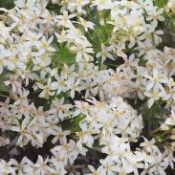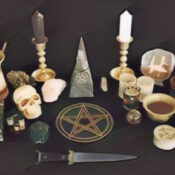Author: A Solitary Pagan
The Cailleach a central figure in Celtic mythology
The Cailleach is a central figure in Celtic mythology, known as the Keeper of Winter and the Shaper of the Land. Her name is found throughout Scottish, Irish, and Manx folklore. She is both respected and feared, representing the wild, untamed forces of nature. The Cailleach is not just a mythological character, but a symbol of the raw power of winter and transformation. The Cailleach is often desc...
Heather
Heather is a plant steeped in magic, folklore, and spiritual significance, making it a cherished ally for witches of all paths. Historically, heather has been revered across the British Isles and Northern Europe, where its purple and white blooms were seen as symbols of luck, protection, and the presence of the fae. In Scottish tradition, white heather is especially prized for its association with...
Pyracantha
Pyracantha, also known as Firethorn, is a striking shrub renowned for its vibrant berries and formidable thorns. Steeped in folklore and magical tradition, Pyracantha has long been valued as a powerful plant of protection, courage, and transformation. Historically, its dense, thorny branches were planted around homes and gardens to create living barriers—both physical and spiritual—warding off int...
Sedum
Sedum, also known as stonecrop, is a hardy succulent revered in witchcraft for its remarkable protective, healing, and grounding properties. Throughout history, Sedum has been planted on cottage roofs and above doorways across Europe, where it was believed to shield homes from lightning, fire, and malevolent spirits. In some regions, it was said that a thriving Sedum plant on the roof foretold goo...
Peony
The peony, with its lush, fragrant blooms and deep roots in history, is a plant steeped in magical lore and spiritual significance. Across cultures and centuries, the peony has been cherished not only for its beauty, but for its potent magical properties and its role in rituals of protection, love, and healing. In witchcraft, peonies are revered for their powerful protective qualities. Their bloss...
Snowdrop (Galanthus nivalis)
The snowdrop, known botanically as Galanthus nivalis, is a perennial herbaceous plant belonging to the Amaryllidaceae family. It is easily recognized by its slender, linear leaves and its distinctive, nodding white flowers, which consist of three larger outer tepals and three smaller inner segments, often marked with a green spot. Snowdrops typically grow from small, underground bulbs and reach a ...
Ceanothus
Ceanothus, often called California Lilac, is a striking shrub known for its vibrant blue or purple flower clusters that burst forth in late spring and early summer. Its glossy, dark green leaves are small and sometimes serrated, forming a lush backdrop for the dazzling blooms. The plant’s arching branches create a graceful, airy silhouette, making it a favorite in gardens for both its beauty and r...
Choisya
Choisya, also known as Mexican Orange Blossom, is a cherished plant in magical herbalism, renowned for its gentle yet potent spiritual properties. Its glossy evergreen leaves and clusters of fragrant white flowers radiate an aura of peace, clarity, and subtle protection. In magical traditions and folklore, Choisya is deeply associated with purity, spiritual cleansing, and the renewal of energy. It...
Grecian Windflower (Anemone blanda ‘Blue Shades’)
The Grecian Windflower, known botanically as Anemone blanda, is a captivating perennial that enchants with its star-shaped blooms in shades of blue, pink, and white. Its delicate, daisy-like petals surround a bright yellow center, rising above finely divided, fern-like leaves. These flowers typically appear in early spring, carpeting woodlands, meadows, and rocky hillsides across the Mediterranean...
Spring Starflower
The Spring Starflower, known botanically as Ipheion uniflorum, is a delicate perennial that graces gardens and wild spaces with its star-shaped blooms each spring. This enchanting plant features slender, grass-like leaves that emerge in late winter, forming a lush green carpet close to the ground. Its flowers, typically pale blue to soft lilac or occasionally white, have six pointed petals arrange...
What you need for a pagan altar
Creating a pagan altar involves choosing items that represent the elements, the seasons, and any deities you honor. The specific objects you select are personal and should reflect your own spiritual practice. Common altar items include an altar cloth, candles for the elements or deities, a bowl of water, incense, and a symbol of earth. You may also add tools for spellwork, crystals, herbs, statues...
Grape Hyacinths
Grape hyacinths, botanically classified as Muscari armeniacum, are perennial bulbous plants native to southeastern Europe and parts of the Mediterranean region. These compact plants are celebrated for their dense, cylindrical clusters of small, bell-shaped flowers, which are most commonly a vivid cobalt or deep blue, though some cultivars may display shades of white or pale violet. Each flower spi...























